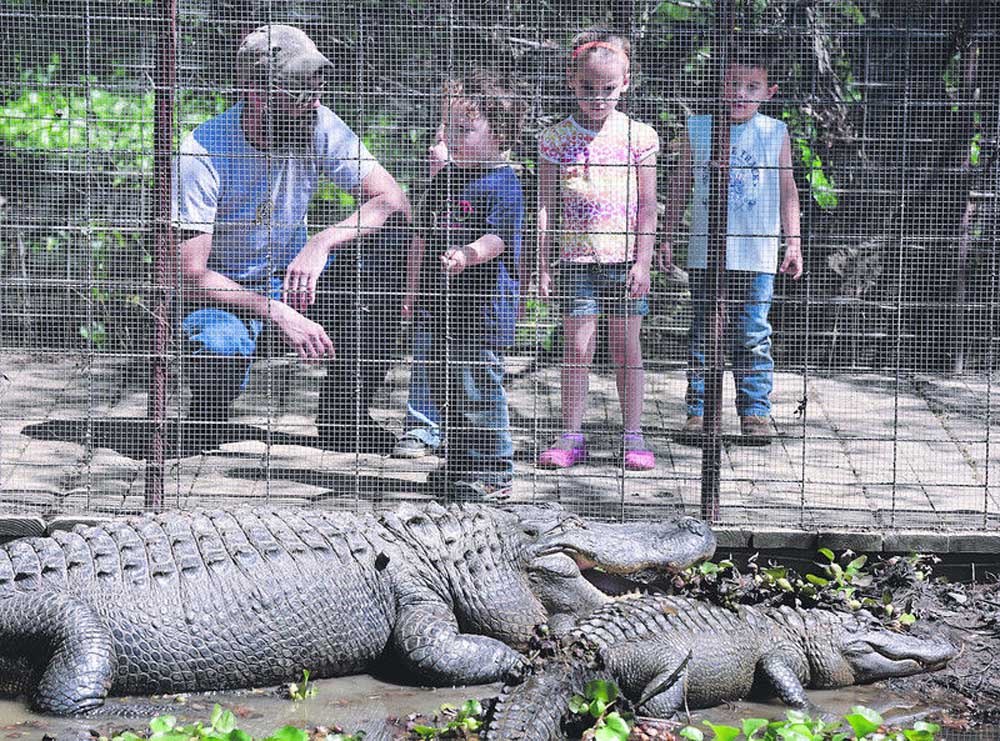East Texas Gator Park features alligators and exotic animals
Published 10:48 am Tuesday, May 17, 2016

- A family observes the alligators behind a safety screen on Thursday, May 5, 2016, at East Texas Gator and Wildlife Park near Grand Saline. Andrew D. Brosig/Tyler Morning Telegraph)
GRAND SALINE – Chomper the alligator doesn’t have many friends, and doesn’t seem concerned about making any.
The grumpy gator spends his days peering out of a murky pond, dark beady eyes staring ahead as he waits patiently for a morsel of raw meat.
In his more social moments, he slides onto the shore to soak up a few rays, but don’t misunderstand his toothy grin as anything but what it is: the jaws of an eating machine.
“They are pretty primitive,” said reptile enthusiast Charlie Harris. “The only thing they know is eating and reproduction.”
Harris and wife, Jana, manage and run East Texas Gators and Wildlife Park, an animal rehabilitation center and sanctuary open all year to the public.
It started out as the couple’s personal rescue mission more than a decade ago and grew from there.
Today, their wildlife escape, which features concessions, weekend grill and gift center, can be found at 9515 Farm-to-Market Road 1255 outside Grand Saline, between Interstate 20 and Highway 110.
It is home to a mixed population of rescued animals – a llama, chinchillas, snakes, prairie dogs, ducks and goats – but it’s the gators who are the undisputed, bellowing kings of the jungle.
With spring in the air, the growling beasts are waking up from a long winter’s nap and their first order of business is finding a bite to eat.
“I always tell the kids not to stick their fingers through the fence,” Harris said with a mischievous grin as he reveals an old hand injury: a missing digit.
RESCUE BUSINESS
To be fair, Harris’ four-fingered hand is not the result of close up encounter with Chomper or any of the dozens of other resident gators.
It’s an unrelated injury that makes for great theater to reinforce the need for safety ahead of selfies.
All kidding aside, the resident gators are not pets or in any way domestic.
Alligators are essentially throwbacks to the days of the dinosaurs – beautiful and territorial and terrifying at the same time.
“We have some here that we raised from eggs,” Harris said. “They’ll still bite you like an alligator.”
The massive reptiles can live for decades, reportedly up to 80 years in captivity, and males can grow to a length of 14 feet or more, although most come in at about 13 feet. Females are about 9 feet.
Some mature specimens can weigh in excess of 1,200 pounds, depending largely on diet, habitat and environmental factors.
Gators are also fast, especially in water, where they are most at home.
“A human can run 10 miles an hour,” he said, noting alligators, by comparison, can travel about 20 miles an hour for short distances.
The gators at the wildlife center are all rescues, trapped within a 25- to 30-mile radius of the facility, including a toothy monster one that blocked traffic on a bridge at Lake Fork.
Specimens are housed in special, watery enclosures that are as close to their natural habits as possible.
Special fencing separates them from the public, but the reptiles are close enough to send a shiver down the spine.
BIRDS, BEES AND BABY GATORS
Springtime seems especially exciting around the park.
Captive alligators breed under water and then the female crawls onto shore to create a nest where she will lay a few dozen eggs.
Her creations vary in size, but most of the nests measure roughly three feet high by six or seven feet in diameter.
It’s essentially a giant compost pile that produces heat as it decays. Water that drips off the female’s body helps hasten the decomposition process, keeping eggs warm and toasty.
Females are apparently wonderful mothers.
“They sit there and stare at their nest,” Harris said. “For about 63 to 65 days, she just sits there and stares at it … and you don’t want to get close to that nest.”
Unfortunately, it’s necessary to steal the eggs before they hatch, lest the tiny squeaking babies become a snack for the other adults.
Coincidently, a female doesn’t eat her own young – just everyone else’s.
So, just how easy it is to raid the nest of an angry alligator?
“We use four people to do it,” Harris said. “It’s quite a dangerous job … the female is dead serious about her eggs.”
Essentially everyone climbs inside a portable fence and carries it to the nest site, carefully placing it over the eggs.
Harris is the lucky guy who gets to retrieve the buried egg treasures while everyone works to keep the chomping, charging mother at bay.
“Anytime we rob eggs it’s always a close call,” he said.
Of the hundreds of eggs harvested over the years, only a handful actually hatched and survived to adulthood.
Survivors can be admired in person at the park, from a safe distance of course.
To see Chomper and all his grumpy friends in action, daily feedings are held at both 11 a.m. and 3 p.m.
The attraction is open daily, from 9 a.m. to 5 p.m.; 9 a.m. to 8 p.m. on Fridays and Saturdays. Admission is $7 for adults; $6 for children 2-12 and seniors, age 65 and up.
For more information, visit www.easttexasgators.com or call 903-962-5630.
TWITTER @ TMT _ Jacque






